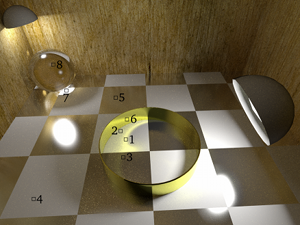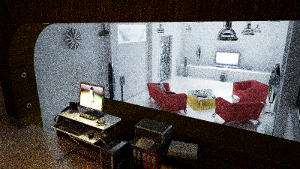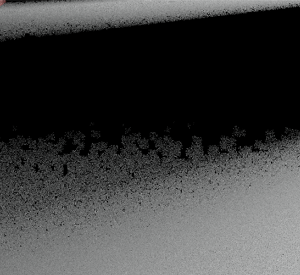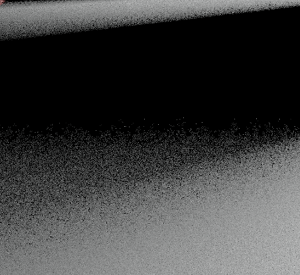Representativity for Robust and Adaptive Multiple Importance Sampling
Anthony Pajot, Loïc Barthe, Mathias Paulin and Pierre Poulin
IEEE Transactions On Visualization and Computer Graphics, August 2011, pp1108-1121.
Abstract
We present a general method enhancing the robustness of estimators based on multiple importance sampling (MIS) in a numerical integration context. MIS minimizes variance of estimators for a given sampling configuration, but when this configuration is less adapted to the integrand, the resulting estimator suffers from extra variance. We address this issue by introducing the notion of ``representativity'' of a sampling strategy, and demonstrate how it can be used to increase robustness of estimators, by adapting them to the integrand. We first show how to compute representativities using common rendering informations such as BSDF, photon maps or caches in order to choose the best sampling strategy for MIS. We then give hints to generalise our method to any integration problem and demonstrate that it can be used successfully to enhance robustness in different common rendering algorithms.


For each location of the test scene (left picture), the right picture shows the MSE of our estimator are in red, and MSE of the other estimators are with a color gradient ranging from dark blue to cyan. Dark blue means rhob = 0.1, cyan means rhob = 1.0, that is pure BSDF-based path-tracing. The x axis corresponds to the number of samples generated to perform one estimation of the value of a pixel, from 2^1 to 2^10.


Probabilities (as pixel intensities) assigned by our method to each strategy for the visible points in the scene. Probabilities of sampling the BSDF are displayed in the top-right image, the ones for sampling the specular map in the bottom-left, and sampling the diffuse indirect map in the bottom-right. The top-left image presents a summary, encoded in the three RGB channels: R for sampling the BSDF, green for sampling the specular map, and B for sampling the diffuse indirect map. Note how sampling the BSDF is favored on the glossy tiles, sampling the diffuse indirect map is favored for the ring caustic on the diffuse tiles, and sampling the specular map is favored under the sphere and on the wall, a specular caustic being created by the right light source.
top
Combinatorial Bidirectional Path-Tracing for Efficient Hybrid CPU/GPU Rendering
Anthony Pajot, Loïc Barthe, Mathias Paulin and Pierre Poulin
Eurographics 2011, Llandudno, Wales (UK).
Abstract
This paper presents a reformulation of bidirectional path-tracing that adequately divides the algorithm into processes efficiently executed in parallel on both the CPU and the GPU. We thus benefit from high-level optimization techniques such as double buffering, batch processing, and asyncronous execution, as well as from the exploitation of most of the CPU, GPU, and memory bus capabilities. Our approach, while avoiding pure GPU implementation limitations (such as limited complexity of shaders, light or camera models, and processed scene data sets), is more than ten times faster than standard bidirectional path-tracing implementations, leading to performance suitable for production-oriented rendering engines.


Images of a scene with a large dataset (758K triangles, lots of textures) featuring complex lighting conditions (glossy reflections, caustics, strong indirect lighting, \etc) computed in respectively 50 seconds (left) and one hour (right). Standard bidirectional path-tracing requires respectively 11 minutes and 13 hours to obtain the same results.



Images obtained after 4 hours of computation. Note that standard bidirectional path tracing reach the same quality in 16 hours.
top
Robust Adaptive Sampling for Monte-Carlo Rendering
Technical Poster - SIGGRAPH Asia 2011, Hong Kong, China
Abstract
Computation times of Monte-Carlo based rendering methods can be lowered by correctly focusing processing power on the parts of the image where convergence is harder to reach.
This can be done efficiently by estimating each pixel's error, or better, using a measure of quality of the pixel (such as entropy-based methods).
However, since these last methods do not uniformize the error over the pixels, they are not very well suited for progressive or time-constrained computations.
As each pixel value is an estimation, a natural error measure is variance.
A problem is that tonemapping can make bright and dim regions look similarly bright in the final image.
Absolute variance cannot be used directly and relative error measures should be used instead. During Monte-Carlo rendering, error measures are often computed from the previous x_i radiance samples. Therefore, pixel sampling depends on the error estimate, which itself depends on pixel sampling, leading to a poor estimate of the actual error for pixels whose initial error estimate is low.
We define a robust error estimator to obtain accurate error estimates, additionally alternating between uniform and adaptive sampling to consistently reduce the error estimate variance for all pixels. We show that our algorithm is robust, and performs similarly to state-of-the-art entropy-based methods, while leading naturally to uniform error over the pixels.


Left : test scene with big penumbra regions, prone to sampling errors.
Right : uniform sampling behave poorly on such regions.


Left : adaptive sampling without alternation : patterns in penumbra.
Right : adaptive sampling without alternation.
top

